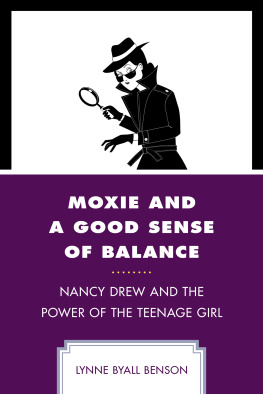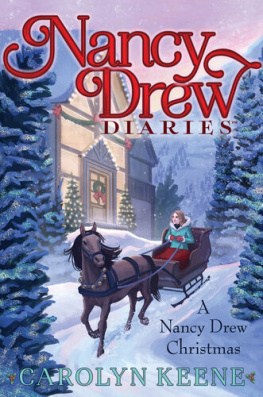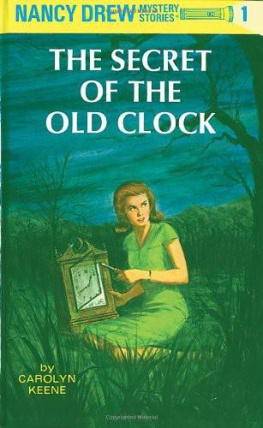Moxie and a Good Sense of Balance
Moxie and a Good Sense of Balance
Nancy Drew and the Power of the Teenage Girl
Lynne Byall Benson
Hamilton Books
Lanham Boulder New York Toronto
Copyright 2018 by
The Rowman & Littlefield Publishing Group, Inc.
4501 Forbes Boulevard
Suite 200
Lanham, Maryland 20706
Hamilton Books Acquisitions Department (301) 459-3366
Unit A, Whitacre Mews, 26-34 Stannary Street,
London SE11 4AB, United Kingdom
All rights reserved
Printed in the United States of America
British Library Cataloging in Publication Information Available
Library of Congress Control Number: 2018956217
ISBN: 978-0-7618-6811-8 (pbk. : alk. paper)
ISBN: 978-0-7618-6974-0 (Electronic)
 The paper used in this publication meets the minimum
The paper used in this publication meets the minimum
requirements of American National Standard for Information
SciencesPermanence of Paper for Printed Library Materials,
ANSI Z39.48-1992
I dedicate this, my first book, to my mother, Mitzi Wolf Byall, who first introduced me to Nancy Drew. Like Nancy, Mom had plenty of moxie!
Acknowledgments
This book would not have been possible without the support of my publisher, Rowman & Littlefield, and its imprint Hamilton Books. Their editors have been very patient in dealing with this book project written by a novice author, and I thank them most appreciatively.
In addition, I thank the chair of Womens, Gender, and Sexuality Studies at the University of Massachusetts Boston, Dr. Elora Chowdhury, who advocated for this project on my behalf, helping me obtain the subvention grant necessary for publication.
I also thank my fellow faculty members in the Womens, Gender, and Sexuality Studies Department for their unwavering support of this, my first foray into the publishing world.
Thanks, also, to my Xian Sisters, Professors Chris Bobel, Carney Maley, Kristin Murphy, and Tara Parker, for their love and advice and for never asking me when my book will be finished.
Words cannot convey how much I have appreciated and enjoyed working with my copy editor, Deborah Justice. She loved this project as much as I did, and it showed in her expertise in helping make me a better writer. Thanks, DJ!
To my stepdaughters, Caetlin and Elisabeth Benson-Allott: I love you both so very much.
To my great chum, Martha Fox: thank you for being a cheerleader on behalf of Nancy and me.
Finally, I thank my husband, John Benson. I love you, and you will always be my Ned Nickerson.
Chapter One
Nancys Timeless Appeal
Nancy Drew first saved the day on April 28, 1930, when she found the missing will, bested the interlopers, and set all to rights in The Secret of the Old Clock . But I first met her years later, in the 1960s, in the pages of my mothers copies of the original titles. As I approached adolescence I faithfully hoarded my babysitting money and allowance in eager anticipation of purchasing the next installment. During those confusing growing-up-years, I learned all too well that being a teen is a challenge and a thrill, but its exhausting. Reading Nancy Drew was a salve, because, I had found, she offers girl readers something more than action-packed adventure: she gives them something original. And perhaps it is because I steadily read Nancy Drew mysteries in my most impressionable years that she has remained with me as an adult.
And Nancy Drew endures today; since 1930, not a single Nancy Drew title has been out of print. But why, when so many literary heroes have vanished from the cultural conversation altogether, has Nancy proven so resilient? Why has Nancy Drew continued to hold our attention over all these years? Maybe its because shes so popular, good-looking, cheerful, well-loved, and comfortable ; in short, Nancy seems to have so much of what many a reader would desire. And she certainly doesnt seem to suffer the anxieties typical of an ordinary teenage girl, granted an unusual level of autonomy. But I think her near-ageless appeal owes to more than this.
Nancy Drew is relevant to todays readers. She is, in short, a contemporary feminist role model for girls. Title by title, young heroine Nancy successfully solves complicated mysteries, often under the guise of assisting her father, famous criminal lawyer Carson Drew. In this she models confident, independent young womanhood. So, while Nancy not only possesses nearly every grace that would have been desired by an early twentieth-century girl reader, she also fully embodies qualities that would have been considered almost exclusively masculine in the 1930s and 40s, when the series popularity was at its height: physical strength, resourcefulness, curiosity, and athleticism.
Undoubtedly, Nancy has morphed over the years as various ghostwriters have assumed the pen; but what interests us is the girl who first appeared in The Secret of the Old Clock , the young gumshoe who solved mysteries throughout the 1930s and 40s. This version of Nancy Drew seems to have managed to be both fully feminine while also exhibiting a remarkable independence that would have then typically been reserved for incorrigible boysa moxie author Betsy Caprio calls Nancys Drew-ness.
I dont mean to say that Nancy and the series are without flaw; the books are a product of their time and sometimes reflect the excesses or prejudices of the era. But at core Nancy Drew remains a timeless embodiment of confidence and agency, independent of changing cultural expectations for girls.
With the series first installment in 1930, a new kind of literary exemplar was born. In an age when the virtuous young woman was praised for excelling in the home arts and appealing to marriageable young men, Nancy Drew managed to fully live both in and outside of what was considered her appropriate, gendered sphere. Qualities that read as novel in the 1930s and 40s are explicitly aspirational to todays young girl readers. And so it is the marriage of typically and atypically feminine qualities so easily assumed by Nancy that I think make her a role model for todays young women.
In my work, I reexamine images of protofeminism, but it wasnt until fairly recently that I began to explore in this light why Nancy holds such an attraction for me. As I am a scholar by profession, I naturally spent a great deal of time methodically considering the question. First, I reread my stash of old Nancy Drew books; in so doing, I began to realize that it was the earlier Nancy of the first decades of her popularity that held greater appeal for me than did the characters later iterations. I then dove into the literary critique. Before long Betsy Caprio became my articulate and perceptive guide in this process, through her most excellent book, The Mystery of Nancy Drew: Girl Sleuth on the Couch .
My systematic reexamination of each Nancy Drew title also considered the illustrations included in the first editions of the series. Each cover and frontispiece shows Nancy elegantly clad in the dress of the erawhich makes her look so much more adult than the typical sixteen-year-old girl we know today. On most of the covers, Nancy is hiding from the books villains, a promise of suspense drawing us in: She could be discovered at any minute! And we never have to turn so very many pages before we are met by Nancys freedom, poise, and capacity to do it all. In fact, we are first introduced to Nancy thus:
Nancy finished her breakfast and then went to the kitchen to consult with Hannah, the maid, concerning the work of the day. Although only sixteen, Nancy was unusually capable, and under her skillful direction everything ran smoothly in the Drew household.
On the death of her mother six years before, she had taken over the entire management of the establishment. The Drews employed one servant, Hannah Gruen, an elderly maid of all work who had been with them for many years.
Next page






 The paper used in this publication meets the minimum
The paper used in this publication meets the minimum